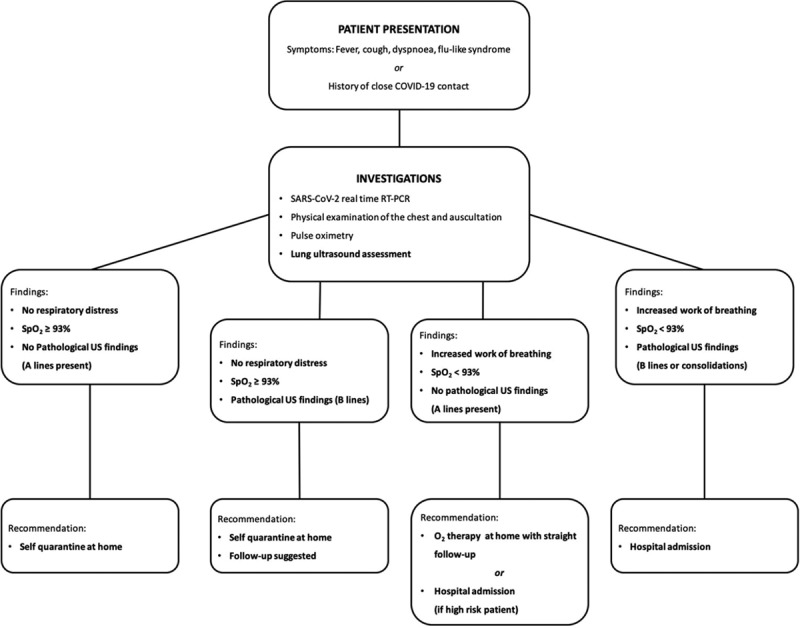To the Editor
Severe acute respiratory syndrome coronavirus 2 (SARS-CoV-2) is a recently pandemic beta-coronavirus, for whichinfection symptoms may vary from fever, dry cough, fatigue, and lymphopenia to viral pneumonia with acute respiratory distress syndrome (ARDS).1
Several studies have proven the greater sensitivity of chest computerized tomography (CT) compared to real-time reverse transcription polymerase chain reaction (RT-PCR) in identifying Coronavirus Disease 2019 (COVID-19) pneumonia; moreover, lung abnormalities may precede clinical manifestations, suggesting chest CT as a better screening test.2,3
Chest CT, however, has several limitations: it is invasive and expensive and requires patient transport to a health care facility; these characteristics could lead to a diagnostic delay, when clinical conditions may already becritical. Furthermore, the risk in transporting unstable hypoxemic patients, and associated nosocomial transmission, further limits chest CT utilization.
The COVID-19 outbreak moves fast, and we need to organize and allocate resources while optimizing costs and time: identification of patients with pneumonia should be rapid and economic.
Lung ultrasound (US) has already proven to be a reliable tool in diagnosing lung inflammatory processes4: the results are immediate andthe examination is safe, repeatable, and cheap. Lung parenchymal alterations can be observed at the onset, and a disposable probe cover can ensure a clean procedure.
Most notably, as opposed to CT imaging, US examinations are easily performed at the point of care, which can be the patient’s bedside or even outside the hospital. All these qualities make it a precious tool in clinical practice, optimal to assist clinicians even in initial patient triage. Early literature suggests that patients with confirmed COVID-19 pneumonia demonstrate typical lung imaging features, including pleural line irregularities, B lines, and multifocal consolidations.5
Early use of lung US could be valuable in COVID-19 patients, leading to early correct diagnoses and appropriate management. One particularly promising setting for this could be triage: in Italy, tents have been mounted outside the hospital as “fieldhospitals” to avoid contact between infected patients and noninfected ones. Providing every tent with an USscanner could permit early diagnosis outside the hospital, effectively implementing a “US triage.”
A US-guided triage algorithm should be developed: one such proposal is shown in theFigure.
Figure.

The ultrasound-guided triage algorithm. COVID-19 indicates Coronavirus Disease 2019; RT-PCR, reverse transcription polymerase chain reaction; SARS-CoV-2, severe acute respiratory syndrome coronavirus 2; Spo2, peripheral oxygen saturation; US, ultrasound.
Limitations for the implementation of UStriage are the lack of specific protocols and operator experience, which influences the validity of test results.
Although the UStriage has not yet been validated by prospective studies, it is a concept that needs prompt definition and investigation to improve our ability to decide which patients need hospitalization immediately when resources are limited and need to be conserved.
Chiara Piliego, MD
Alessandro Strumia, MD
Unit of Anaesthesia, Intensive Care and Pain Management
Department of Medicine
Università Campus Bio-Medico di Roma
Rome, Italy
a.strumia@unicampus.it
Michael Benjamin Stone, MD
Department of Emergency Medicine
Legacy Emanuel Medical Center
Portland, Oregon
Giuseppe Pascarella, MD
Unit of Anaesthesia, Intensive Care and Pain Management
Department of Medicine
Università Campus Bio-Medico di Roma
Rome, Italy
REFERENCES
- 1.Zhang JJ, Dong X, Cao YY, et al. Clinical characteristics of 140 patients infected with SARS-CoV-2 in Wuhan, China. Allergy. 2020February19 [Epub ahead of print]. [DOI] [PubMed] [Google Scholar]
- 2.Fang Y, Zhang H, Xie J, et al. Sensitivity of chest CT for COVID-19: comparison to RT-PCR. Radiology. 2020. [Epub ahead of print]. [DOI] [PMC free article] [PubMed] [Google Scholar]
- 3.Salehi S, Abedi A, Balakrishnan S, Gholamrezanezhad A. Coronavirus Disease 2019 (COVID-19): a systematic review of imaging findings in 919 patients. Am J Roentgenol 2020;215:1–7. [DOI] [PubMed] [Google Scholar]
- 4.Long L, Zhao HT, Zhang ZY, Wang GY, Zhao HL. Lung ultrasound for the diagnosis of pneumonia in adults: a meta-analysis. Medicine (Baltimore). 2017;96:e5713. [DOI] [PMC free article] [PubMed] [Google Scholar]
- 5.Peng QY, Wang XT, Zhang LN. Findings of lung ultrasonography of novel corona virus pneumonia during the 2019-2020 epidemic. Intensive Care Med 2020. [Epub ahead of print]. [DOI] [PMC free article] [PubMed] [Google Scholar]


